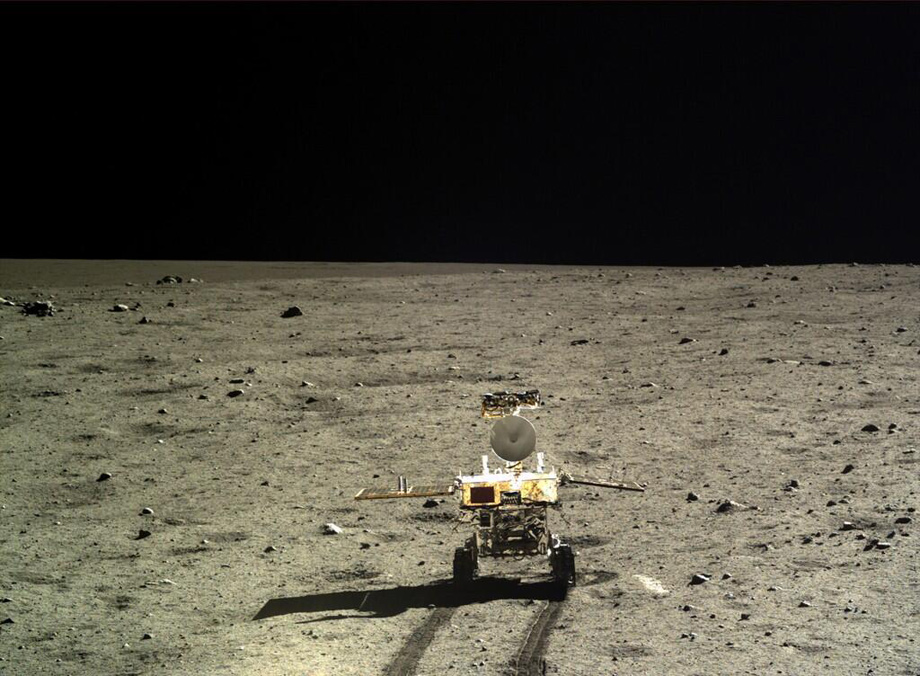It looks like you're using an Ad Blocker.
Please white-list or disable AboveTopSecret.com in your ad-blocking tool.
Thank you.
Some features of ATS will be disabled while you continue to use an ad-blocker.
share:
SayonaraJupiter
Ove38
Look at the video camera cable and the antenna cable, they are not moving, neither does the astronaut, look at the astronaut's left arm it's not moving either, it's a dummy in a remote controlled toy car. Look at the tire tracks at 0:57 the rover model is in fact going backwards
The driver's arm has no flexibility... not even to wave to the camera... I'm looking for any visual hints that there might be someone alive in that suit.
There is some good footage (for comparison) in NASA's film "Nothing so hidden..." (1972) catalogue HQ-222.
Yes, the driver's arm has no flexibility, that's not normal
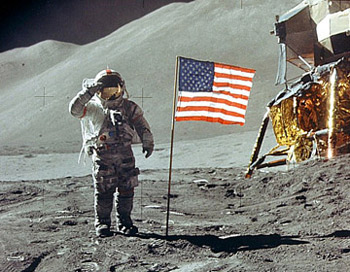
Ove38
smurfy
A remastered short clip of the Apollo 16 rover. So amazing a quality, you could almost be there. I hope more old space film will be done like this!
Look at the video camera cable and the antenna cable, they are not moving,
They're stiff cables.
neither does the astronaut, look at the astronaut's left arm it's not moving either,
Why would it? You do know how it was operated right?
it's a dummy in a remote controlled toy car. Look at the tire tracks at 0:57 the rover model is in fact going backwardsedit on 22-12-2013 by Ove38 because: text fix
No it isn't and no it isn't. Listen to the mission audio or read the transcripts, they are heading back over tracks they have already made.
Ove38
it's a dummy in a remote controlled toy car. Look at the tire tracks at 0:57 the rover model is in fact going backwards
onebigmonkeyNo it isn't and no it isn't. Listen to the mission audio or read the transcripts, they are heading back over tracks they have already made.
Yes it is. When they drive over the old tire tracks that proves they are on a small studio stage and not on the "moon".
edit on 12/23/2013 by SayonaraJupiter because: tags bloody tags
onebigmonkey
Ove38
smurfy
A remastered short clip of the Apollo 16 rover. So amazing a quality, you could almost be there. I hope more old space film will be done like this!
Look at the video camera cable and the antenna cable, they are not moving,
They're stiff cables.
neither does the astronaut, look at the astronaut's left arm it's not moving either,
Why would it? You do know how it was operated right?
Why would it? Because of a very bumpy ride ! The arm is as stiff as the steel wire used to model the video camera cable and the antenna cable of the toy car in the video.
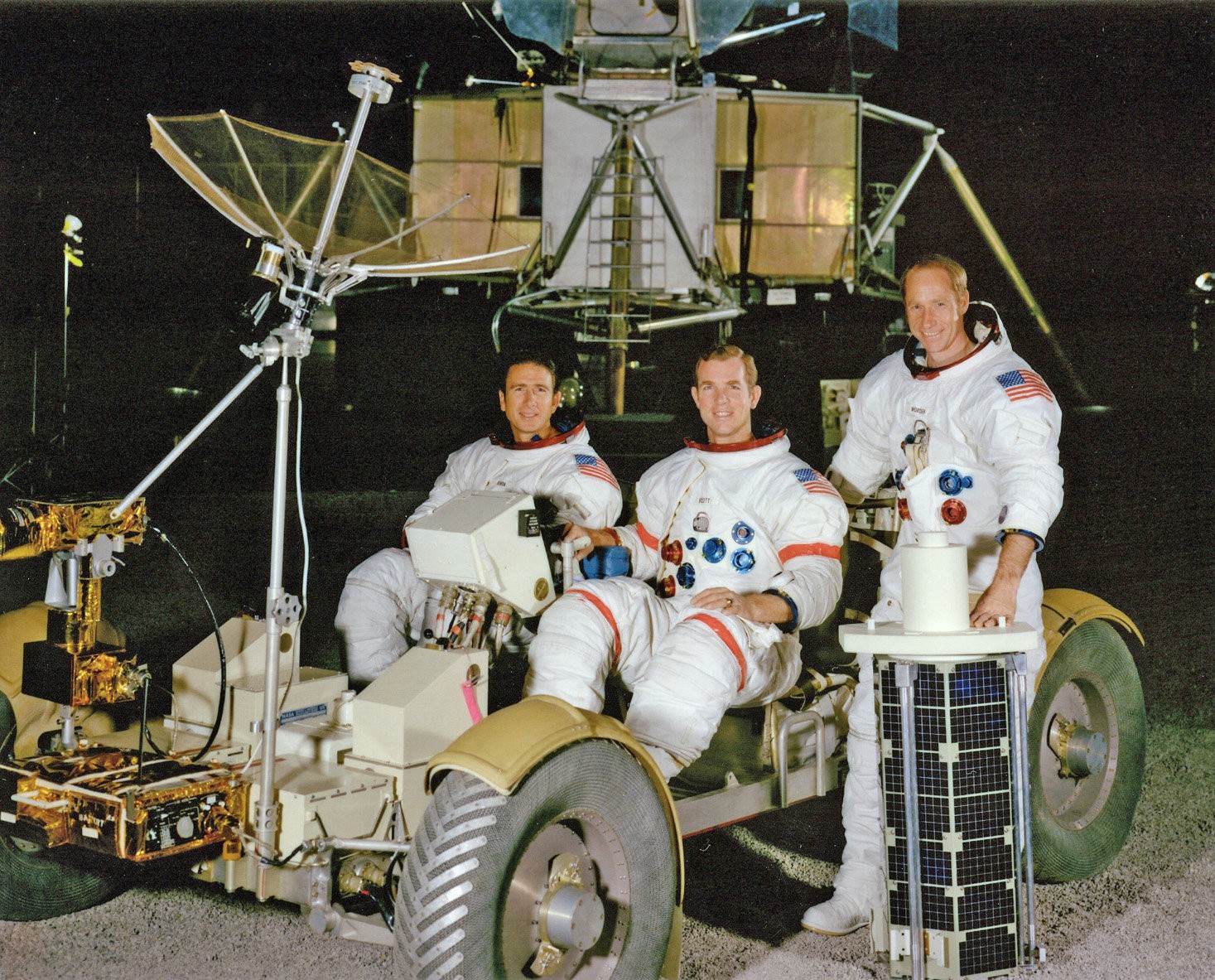
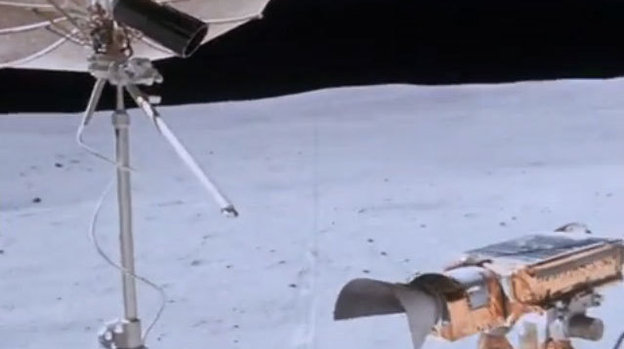
edit on 23-12-2013 by Ove38 because: text fix
reply to post by SayonaraJupiter
SERIOUSLY look at the detail in the top lander image compared to the bottom there is MORE detail in the bottom image
Look at the rocks or the lander or the Astronaut on the rover then get them eyes tested!!!
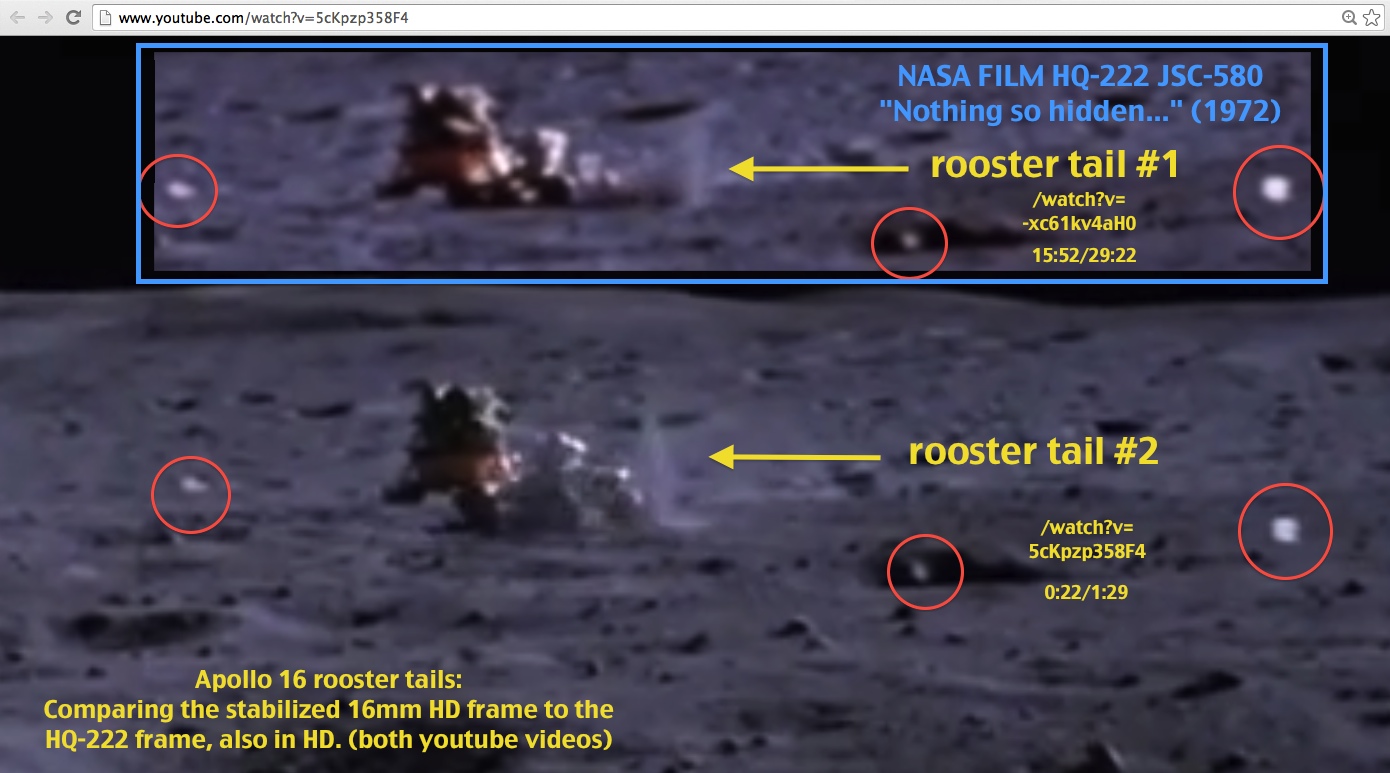
SERIOUSLY look at the detail in the top lander image compared to the bottom there is MORE detail in the bottom image
Look at the rocks or the lander or the Astronaut on the rover then get them eyes tested!!!

reply to post by wmd_2008
I looked at both videos, and SayonaraJupiter is right, it was too separate drives. The dust is kicked up differently, and the rover bumps up and down and turns slightly differently. Still doesn't prove that it wasn't on the Moon, but it's an interesting tidbit to learn.
Here are the two videos:
I looked at both videos, and SayonaraJupiter is right, it was too separate drives. The dust is kicked up differently, and the rover bumps up and down and turns slightly differently. Still doesn't prove that it wasn't on the Moon, but it's an interesting tidbit to learn.
Here are the two videos:
Ove38
onebigmonkey
Ove38
smurfy
A remastered short clip of the Apollo 16 rover. So amazing a quality, you could almost be there. I hope more old space film will be done like this!
Look at the video camera cable and the antenna cable, they are not moving,
They're stiff cables.
neither does the astronaut, look at the astronaut's left arm it's not moving either,
Why would it? You do know how it was operated right?
Why would it? Because of a very bumpy ride ! The arm is as stiff as the steel wire used to model the video camera cable and the antenna cable of the toy car in the video.
edit on 23-12-2013 by Ove38 because: text fix
Uh-huh.
You're wrong, obviously. The arm is stiff because it is in a stiff suit. The car is driving in a low gravity and zero atmosphere, which can be seen by the behaviour of the dust being thrown up. They drove some distance, much more than is shown in the video clip, and then they drove back.
But you can prove you're right I guess....
wildespace
reply to post by wmd_2008
I looked at both videos, and SayonaraJupiter is right, it was too separate drives. The dust is kicked up differently, and the rover bumps up and down and turns slightly differently. Still doesn't prove that it wasn't on the Moon, but it's an interesting tidbit to learn.
There was always those two drives back and forth in the film, and panned by the camera. Both of them are back to back in the original hour+ long version I posted later. The drive I posted on page one is the second of the two.
edit on 23-12-2013 by smurfy because: (no reason
given)
reply to post by wmd_2008
I don't want to sound simplistic, but isn't the shuttle designed for space travel? I'm wondering why the shuttle couldn't travel to the moon and back, what design features would be needed to do a spin around our satellite? I would be shocked if the set-up NASA used in '69 was in any way more sophisticated or capable than the shuttle for performing a fly-by around the moon and back. I am not attacking, just wondering out loud if that makes any sense to you?
I don't want to sound simplistic, but isn't the shuttle designed for space travel? I'm wondering why the shuttle couldn't travel to the moon and back, what design features would be needed to do a spin around our satellite? I would be shocked if the set-up NASA used in '69 was in any way more sophisticated or capable than the shuttle for performing a fly-by around the moon and back. I am not attacking, just wondering out loud if that makes any sense to you?
Stackpot
reply to post by wmd_2008
I don't want to sound simplistic, but isn't the shuttle designed for space travel? I'm wondering why the shuttle couldn't travel to the moon and back, what design features would be needed to do a spin around our satellite? I would be shocked if the set-up NASA used in '69 was in any way more sophisticated or capable than the shuttle for performing a fly-by around the moon and back. I am not attacking, just wondering out loud if that makes any sense to you?
The Apollo technology wasn't that sophisticated, but it was specifically designed for the job of getting into lunar orbit and then sending a lander down. The main need for that is propellant, not so much for getting there but getting out of Earth orbit (with more to get into and out of lunar orbit). Apollo didn't use a lot of fuel on the way, just enough to make minor corrections to trajectory, but it did use a large amount getting out of Earth orbit (it was still attached to the final stage of the Saturn V rocket to do that.
The launch mass of the Apollo command module and lunar module was around 30 tonnes. The Space shuttle mass is 80 tonnes empty, so there is considerably more of it to move out of orbit. That larger mass also needs controlling, so it would need more fuel than the Apollo vehicle to make course changes, to slow it down into lunar orbit, make changes in that orbit, and finally to send it on its way back home.
reply to post by Stackpot
onebigmonkey is correct, it's not so much the question of sophistication as the question of fuel. Look at the size of Saturn V rocket compared to the Command/Service module sitting on top of it. Then look at the size of the Shuttle stack compared to the Shuttle itself:
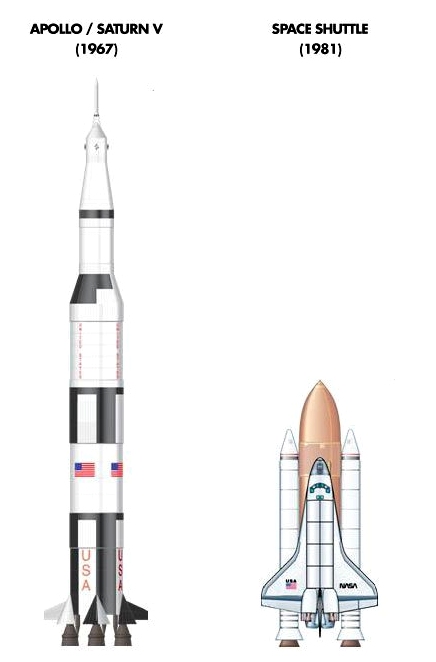
You need the kind of a Saturn V rocket just to get to the Moon. Compared to it, the Shuttle is a fat little midget!
The Shuttle's 2 SRBs are expended and drop off just 2 minutes after lift-off. By the time the Shuttle's external fuel tank drops off in low-earth orbit, it's nearly empty too. There's no more fuel left apart from what's needed for orbital corrections and returning back to Earth. Even if you filled the whole of the Shuttle's payload bay with fuel, the maneuvering rocket system wouldn't be powerful enough to defeat the Earth's gravity and launch the Shuttle towards the Moon.
onebigmonkey is correct, it's not so much the question of sophistication as the question of fuel. Look at the size of Saturn V rocket compared to the Command/Service module sitting on top of it. Then look at the size of the Shuttle stack compared to the Shuttle itself:

You need the kind of a Saturn V rocket just to get to the Moon. Compared to it, the Shuttle is a fat little midget!
The Shuttle's 2 SRBs are expended and drop off just 2 minutes after lift-off. By the time the Shuttle's external fuel tank drops off in low-earth orbit, it's nearly empty too. There's no more fuel left apart from what's needed for orbital corrections and returning back to Earth. Even if you filled the whole of the Shuttle's payload bay with fuel, the maneuvering rocket system wouldn't be powerful enough to defeat the Earth's gravity and launch the Shuttle towards the Moon.
edit on 26-12-2013 by wildespace because: (no reason given)
And just to clarify it even further for those not familiar with what they're looking at, the CSM at the top of the Saturn is about the size of the
Shuttle cockpit area, so the entire Saturn stack is needed just to get that small tin can on its way.
reply to post by onebigmonkey
That is a great explanation, thanks for taking the time to explain in depth. I was under the assumption that once the vehicle was in orbit the amount of fuel needed for maneuvering and adjustments was minimal. Back in the day they made it sound like some sort of slingshot maneuver that used centrifugal force and gravity to do most of the heavy lifting.
That is a great explanation, thanks for taking the time to explain in depth. I was under the assumption that once the vehicle was in orbit the amount of fuel needed for maneuvering and adjustments was minimal. Back in the day they made it sound like some sort of slingshot maneuver that used centrifugal force and gravity to do most of the heavy lifting.
reply to post by wildespace
That is a great explanation, thanks for taking the time to explain in depth. I was under the assumption that once the vehicle was in orbit the amount of fuel needed for maneuvering and adjustments was minimal. Back in the day they made it sound like some sort of slingshot maneuver that used centrifugal force and gravity to do most of the heavy lifting.
That is a great explanation, thanks for taking the time to explain in depth. I was under the assumption that once the vehicle was in orbit the amount of fuel needed for maneuvering and adjustments was minimal. Back in the day they made it sound like some sort of slingshot maneuver that used centrifugal force and gravity to do most of the heavy lifting.
reply to post by smurfy
How come you can't see any stars?
Where is the audio?
WTF worst fake moon landing I have ever seen!
How come you can't see any stars?
Where is the audio?
WTF worst fake moon landing I have ever seen!
agentscoly
reply to post by smurfy
How come you can't see any stars?
Where is the audio?
WTF worst fake moon landing I have ever seen!
Nice trolling, bro.
wmd_2008
Fearthedarkforiaminit
Gibborium
Fearthedarkforiaminit
Problem with that is that whole frame will ghost, not just portions. In the kitchen video you offered, yo can plainly see that the entire frame is "ghosted" as you would expect. In the clip of the lunar landing only the astronaut is supposedly ghosting. In addition, the ghosting never once affects the horizon or bleeds into the sky. You can see on the kitchen video that the ghosting overlays the entire frame, as it should. If the same happened in the lunar sequence, problem solved, but it does not. Watch them both side by side and think for yourself. Maybe I'll do a comparison video if folks are interested.
Yes you are correct that the whole frame ghosts in wmd_2008's video. However, your conclusion is faulty. In wmd_2008's video example the camera is being moved (panned) and the subject matter is static. This causes the ghosting of the subject matter to move across the screen.
However, in the Apollo TV video, the camera is static and the astronaut is moving. This causes the astronaut to move into the ghosting area. The ghosting remains stationary and makes it appear the astronaut is transparent.
Conclusion, wmd_2008 is correct in his analysis and ghosting is the culprit.
Well, for anyone who hasn't already made up their mind, the above argument would have you believe that anytime you use this camera and there is movement, whether its the camera moving or the subject, it will cause ghosting. So there should be plenty of examples of this effect. As a matter of fact anything ever shot with this camera should do it. Bring on the footage.
Go to 2:40 on this one and see a similar effect to the Armstrong one now will you accept it!!!!!
You will see the background through him.edit on 21-12-2013 by wmd_2008 because: (no reason given)
First off, anyone who strives so hard to convince me to accept their version of reality is automatically suspect in my mind. Second, I watched the WHOLE video you sent and he has to adjust the camera to its extremes in order to produce the ghosting effect SIMILAR but not IDENTICAL to the Apollo landing effect and more importantly, I did a search on google to see what camera was used on the Lunar module and its a Westinghouse camera using a Westinghouse WL30691 sensor not a Vidicon sensor. (That was used on the command module camera, you know, the part that stayed in space.) So, guess you need to start over and find some footage from the right camera. Here's a link to wikipedia to get you started. Good luck.
Wiki Link
Fearthedarkforiaminit
wmd_2008
Fearthedarkforiaminit
Gibborium
Fearthedarkforiaminit
Problem with that is that whole frame will ghost, not just portions. In the kitchen video you offered, yo can plainly see that the entire frame is "ghosted" as you would expect. In the clip of the lunar landing only the astronaut is supposedly ghosting. In addition, the ghosting never once affects the horizon or bleeds into the sky. You can see on the kitchen video that the ghosting overlays the entire frame, as it should. If the same happened in the lunar sequence, problem solved, but it does not. Watch them both side by side and think for yourself. Maybe I'll do a comparison video if folks are interested.
Yes you are correct that the whole frame ghosts in wmd_2008's video. However, your conclusion is faulty. In wmd_2008's video example the camera is being moved (panned) and the subject matter is static. This causes the ghosting of the subject matter to move across the screen.
However, in the Apollo TV video, the camera is static and the astronaut is moving. This causes the astronaut to move into the ghosting area. The ghosting remains stationary and makes it appear the astronaut is transparent.
Conclusion, wmd_2008 is correct in his analysis and ghosting is the culprit.
Well, for anyone who hasn't already made up their mind, the above argument would have you believe that anytime you use this camera and there is movement, whether its the camera moving or the subject, it will cause ghosting. So there should be plenty of examples of this effect. As a matter of fact anything ever shot with this camera should do it. Bring on the footage.
Go to 2:40 on this one and see a similar effect to the Armstrong one now will you accept it!!!!!
You will see the background through him.edit on 21-12-2013 by wmd_2008 because: (no reason given)
First off, anyone who strives so hard to convince me to accept their version of reality is automatically suspect in my mind. Second, I watched the WHOLE video you sent and he has to adjust the camera to its extremes in order to produce the ghosting effect SIMILAR but not IDENTICAL to the Apollo landing effect and more importantly, I did a search on google to see what camera was used on the Lunar module and its a Westinghouse camera using a Westinghouse WL30691 sensor not a Vidicon sensor. (That was used on the command module camera, you know, the part that stayed in space.) So, guess you need to start over and find some footage from the right camera. Here's a link to wikipedia to get you started. Good luck.
Wiki Link
It is appropriate to discuss a vidicon tube, as the ghosting is not a product of the TV camera used on the moon but the scan conversion process back on the ground.
www.hq.nasa.gov...
honeysucklecreek.net...
www.hq.nasa.gov...
onebigmonkey
Fearthedarkforiaminit
wmd_2008
Fearthedarkforiaminit
Gibborium
Fearthedarkforiaminit
Problem with that is that whole frame will ghost, not just portions. In the kitchen video you offered, yo can plainly see that the entire frame is "ghosted" as you would expect. In the clip of the lunar landing only the astronaut is supposedly ghosting. In addition, the ghosting never once affects the horizon or bleeds into the sky. You can see on the kitchen video that the ghosting overlays the entire frame, as it should. If the same happened in the lunar sequence, problem solved, but it does not. Watch them both side by side and think for yourself. Maybe I'll do a comparison video if folks are interested.
Yes you are correct that the whole frame ghosts in wmd_2008's video. However, your conclusion is faulty. In wmd_2008's video example the camera is being moved (panned) and the subject matter is static. This causes the ghosting of the subject matter to move across the screen.
However, in the Apollo TV video, the camera is static and the astronaut is moving. This causes the astronaut to move into the ghosting area. The ghosting remains stationary and makes it appear the astronaut is transparent.
Conclusion, wmd_2008 is correct in his analysis and ghosting is the culprit.
Well, for anyone who hasn't already made up their mind, the above argument would have you believe that anytime you use this camera and there is movement, whether its the camera moving or the subject, it will cause ghosting. So there should be plenty of examples of this effect. As a matter of fact anything ever shot with this camera should do it. Bring on the footage.
Go to 2:40 on this one and see a similar effect to the Armstrong one now will you accept it!!!!!
You will see the background through him.edit on 21-12-2013 by wmd_2008 because: (no reason given)
First off, anyone who strives so hard to convince me to accept their version of reality is automatically suspect in my mind. Second, I watched the WHOLE video you sent and he has to adjust the camera to its extremes in order to produce the ghosting effect SIMILAR but not IDENTICAL to the Apollo landing effect and more importantly, I did a search on google to see what camera was used on the Lunar module and its a Westinghouse camera using a Westinghouse WL30691 sensor not a Vidicon sensor. (That was used on the command module camera, you know, the part that stayed in space.) So, guess you need to start over and find some footage from the right camera. Here's a link to wikipedia to get you started. Good luck.
Wiki Link
It is appropriate to discuss a vidicon tube, as the ghosting is not a product of the TV camera used on the moon but the scan conversion process back on the ground.
www.hq.nasa.gov...
honeysucklecreek.net...
www.hq.nasa.gov...
Hey Monkey,
Only the first link is remotely relevant. The 2nd has no mention of Vidicon tubes and the third link says just what I said in my previous post. The vidicon tube was in a camera mounted on the command module which never made it down to the moon. It goes on to say that westinghouse cameras were used on the surface. So, not real sure where you were going with it? However the discussion in the first link is marginally relevant but it is discussing lens flares which is a completely different phenomenon that happens with almost any camera. Again, I've read what others are offering as "proof", but I don't see anything remotely connected to the subject. And I'll say again, if these cameras had this issue as so many claim, why don't we see evidence of it in TV shows or news broadcasts from the period? Surely anything shot with these cameras would have the same defects/anomolies as this footage. Why isn't all footage shot with these cameras "ghosted" in this manner. Occam's Razor. Think for yourself.
new topics
-
Just a thought by John Walsh on the election
2024 Elections: 2 minutes ago -
Trump's truth and reconciliation commission
Politicians & People: 37 minutes ago -
Liberal women going on sex strike over Trump win
US Political Madness: 48 minutes ago -
Where ARE the 20 million votes??? Where ARE they????? WHERE???
US Political Madness: 2 hours ago -
President-Elect DONALD TRUMP's 2nd-Term Administration Takes Shape.
Political Ideology: 3 hours ago -
The Democratic Party’s Stay Behind Program
US Political Madness: 4 hours ago -
Celestial Objects in Far Northern Reaches of Alaska (Polar Mystery)
Fragile Earth: 5 hours ago -
82 yr Woman Arrested for Hate Crime after Assaulting Trump Supporters
2024 Elections: 6 hours ago -
Groaners II
Jokes, Puns, & Pranks: 8 hours ago -
Lunacy
Short Stories: 9 hours ago
top topics
-
Where ARE the 20 million votes??? Where ARE they????? WHERE???
US Political Madness: 2 hours ago, 16 flags -
All Talk No Walk Celebrities Blowing Smoke
US Political Madness: 12 hours ago, 16 flags -
Interesting timing 40 monkeys flee medical lab in US
Diseases and Pandemics: 11 hours ago, 15 flags -
Arizona and Nevada Called for Trump – Giving Trump 312 Electoral Votes
2024 Elections: 13 hours ago, 14 flags -
What shenanigans are at play with the house races?
2024 Elections: 16 hours ago, 12 flags -
Why Dems Are Probably Wishing Trump Won in 2020...
US Political Madness: 10 hours ago, 10 flags -
The Democratic Party’s Stay Behind Program
US Political Madness: 4 hours ago, 10 flags -
President-Elect DONALD TRUMP's 2nd-Term Administration Takes Shape.
Political Ideology: 3 hours ago, 9 flags -
A question about abortion and the states
US Political Madness: 16 hours ago, 8 flags -
82 yr Woman Arrested for Hate Crime after Assaulting Trump Supporters
2024 Elections: 6 hours ago, 8 flags
active topics
-
President-Elect DONALD TRUMP's 2nd-Term Administration Takes Shape.
Political Ideology • 19 • : fringeofthefringe -
Just a thought by John Walsh on the election
2024 Elections • 0 • : Lumenari -
Lunacy
Short Stories • 3 • : FullHeathen -
Can you prove that you are not a bot ?
General Chit Chat • 44 • : KnowItAllKnowNothin -
Liberal women going on sex strike over Trump win
US Political Madness • 8 • : rickymouse -
TODAY IS A HUGE ELECTION DAY FOR AMERICA - November 5th 2024 - Reports from Around The Nation.
2024 Elections • 740 • : WeMustCare -
Where ARE the 20 million votes??? Where ARE they????? WHERE???
US Political Madness • 18 • : berbofthegreen -
Post A Funny (T&C Friendly) Pic Part IV: The LOL awakens!
General Chit Chat • 7751 • : underpass61 -
On Nov. 5th 2024 - AMERICANS Prevented the Complete Destruction of America from Within.
2024 Elections • 114 • : WeMustCare -
About that ''Iron Dome''
Other Current Events • 34 • : BingoMcGoof

